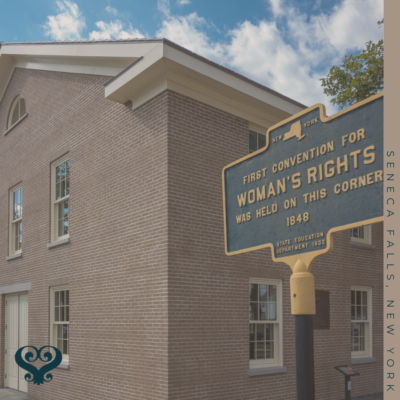Alongside Highway 5 in upstate New York sits a humble brick chapel in the idyllic small town that served as the inspiration for the 1946 film, It’s a Wonderful Life. The two-story building now corners a block adorned with street lights decorated with the American flag. The manicured yard to the left of the building provides an open space to view the murals scaling the Women’s Rights National Historical Park.
173 years ago, over 200 middle and upper-class white women were here in Seneca Falls with activism on their mind. Most would be wearing elaborate hats and long dresses that would appear quite formal today. In an older version of the same town, Wesleyan Chapel, as it was called then, served as an ideal spot for convening and was known as a “local haven for anti-slavery activity, political rallies, and free speech events.”
The Seneca Falls Convention marked the beginning of the women’s rights movement in the US. Initially exclusive to women, it later welcomed male supporters like Frederick Douglass. Led by Elizabeth Cady Stanton and Mary Ann M’Clintock, the Declaration of Sentiments underscored women’s equality and encouraged civic engagement. Despite being written into history as a convening for women’s rights, the convention notably lacked diversity. The only women present at the Seneca Falls Convention were white.
Before 1920, Women did not have the right to vote and were often forced to submit to laws of which they did not consent. Women were widely expected to be obedient to their husbands, routinely receiving unequal rights upon divorce, including sometimes being separated from their children. Local and vocal abolitionists saw parallels between the struggle of white women and Black men, and sought social reform for both groups.
Considered the start of the “women’s rights movement” in the U.S., Seneca Falls set the tone for feminism for generations. The exclusion of women of color’s voices has been a feature of white feminism for decades. Today, the fight for suffrage rages on. We can only wonder what might have been at Wesleyan Chapel if the women of Seneca Falls had convened across racial differences and created a movement anchored in solidarity.

